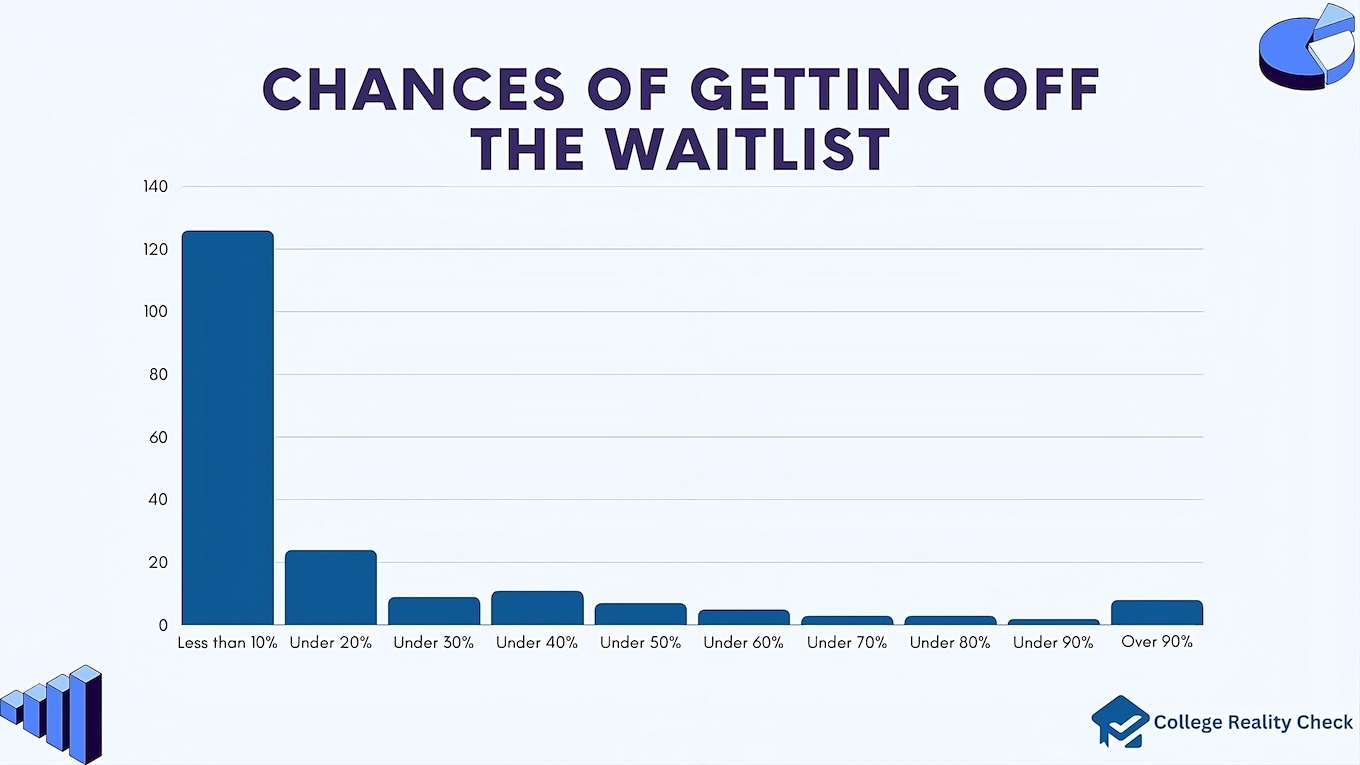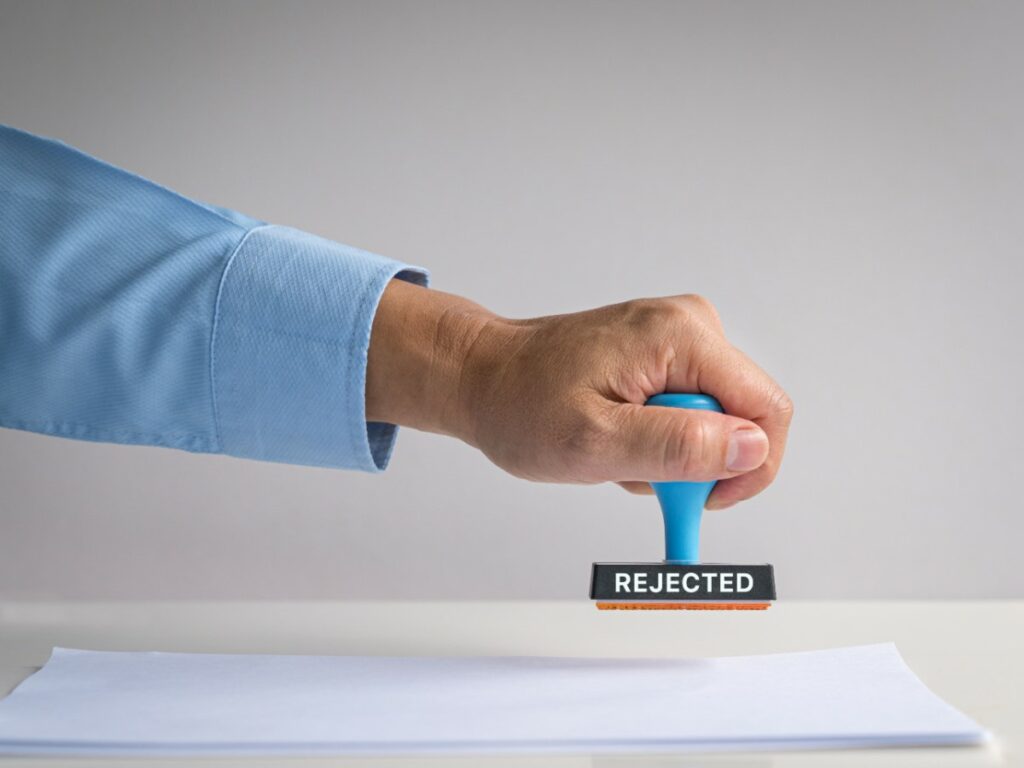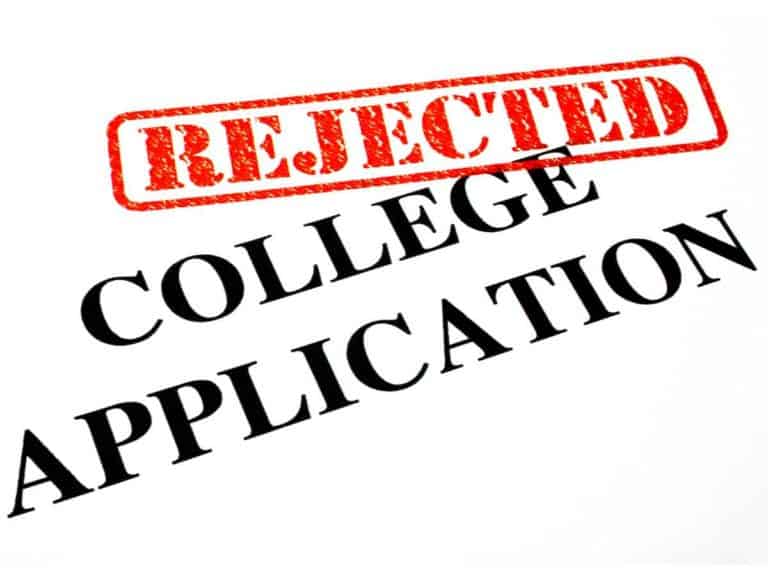Does Waitlist Mean Rejection – In 30% of Cases The Answer is YES
Getting waitlisted from a college means being put in between an acceptance and a rejection. You have neither gained admission nor been denied acceptance. However, the waitlist always turns into either an acceptance or rejection.
The college/university will follow up at a later date and inform the student on whether they were accepted or not.
If you were waitlisted read this article till the end before accepting the offer from the college.
I will explain how to find out how high your chances are, how to put yourself in the best position to be accepted, and how to cope with rejection.
But first, let’s look at some interesting facts.
5 Interesting Facts About College Waitlists
I collected the information about the top 318 colleges – the list came from Princeton Review.
Only 198 colleges presented waitlist data in the form of CDS (Common Data Set), so all stats below are based on the data from those institutions.
26 Colleges Admit No One off the Waitlist
Most colleges that do not accept anyone from their lists are very selective.
I think you wouldn’t be surprised to see Princeton and MIT among them.
The worst thing about this is that so many students accept a place on the waiting list without realizing that they have zero chance of getting admitted.
But why do colleges do that? Why do they waitlist students without the intention of admitting them later?
There is a phenomenon called soft denial: some admission officers want to soften the blow of being rejected. They think that being waitlisted is better than being rejected.
But the fact is that in the case of colleges that accept 0 students, waitlist means denied acceptance.
So, if your dream college is in the list below, you better move on and not hope of being admitted later:
If you are wondering why colleges use wait lists, then there are 3 main reasons:
- Gauging demonstrated interest. Basically, applicants are given a choice to either continue on the waitlist or pull their application. If you accept your spot, you are essentially showing the college that you are very interested in them. Consider it a final test to ensure you’re serious about attending the school.
- The college likes you, but they want to see how many accepted students enroll. Schools have a limited number of students they can support (in terms of housing, financial aid, class size, etc.), so if the number of students who decide to enroll is lower than the college projects, they start accepting students off the waitlist.
- Yield Protection. Yield is the ratio of students who enrolled to the students accepted. The higher the yield, the more prestigious the college. Accepting students off the waitlist helps increase the school’s yield.
34 Colleges Accept Less than 1% of Students
The next list is marginally better – universities that accept less than 1% of applicants.
For example, Carnegie Mellon University offered 8,986 spots, and 4,652 students accepted the waitlist offer. However, only 43 students were admitted later, which corresponds to the acceptance rate of 0.92%.
While 1% is better than 0, the reality is that you will most likely be rejected if you were waitlisted by these colleges:
If you add 26 colleges that accept no one and 34 that accept less than 1%, the number of colleges that recruit to reject amounts to 30%.
63% of Top Colleges Accept Less Than 10% Off Waitlist
Here’s the distribution of admit rates for the top colleges in our research.

As you can see from the chart above, the majority of colleges, around 63% (or 126 of 198) accept less than 10% of students off their waitlists.
8 Universities Accept Everyone
While the odds of getting in are not high, there is still hope for some students.
We found 8 colleges that accept everyone who agrees to get on the waitlist:
Only 5 Colleges Rank Candidates
Most students believe that there the waitlist is ordered and someone ranked #10 has higher chances than someone ranked #100.
In most cases, this is not true.
How do colleges decide who will be admitted eventually?
As a general rule, colleges have a certain number of spots to fill for the upcoming class.
After the May 1st deadline, they are able to see exactly how many students choose to enroll.
If there are spots still available, then they look at the waitlist.
Another important factor regarding available spaces is a certain college/major falling short of students.
It’s not only a general number that the university expects to have, but also professors and other faculty expecting a certain number of students to take their class.
Let me explain with an example:
Northwestern University has six colleges: Weinberg College of Arts & Sciences, McCormick College of Engineering, School of Communication, Medill School of Journalism, School of Education & Social Policy, and Bienen School of Music.
Within these schools, you have different majors as well.
Let’s say that there are plenty of people in all but one college: the McCormick College of Engineering.
Admissions officers would then look at the waitlist and decide amongst students who applied with an intended major that is found in the McCormick College of Engineering.
And since admissions do not know who will matriculate, they don’t need to rank students in their pool.
Except for these colleges:
The following is a table with waitlist statistics for 198 top colleges: use search to see your chances of being admitted:
| University | State | Offered | Accepted | Admitted |
|---|---|---|---|---|
| Allegheny College | PA | 48 | 6 | 2 |
| American University | DC | 9,146 | 2,086 | 88 |
| Amherst College | MA | 1,419 | 902 | 36 |
| Appalachian State University | NC | 1,350 | 612 | 194 |
| Babson College | MA | 2,699 | 1,286 | 0 |
| Barnard College | NY | 2,524 | 1,597 | 66 |
| Bates College | ME | 2,441 | 1,264 | 0 |
| Baylor University | TX | 3,767 | 819 | 491 |
| Beloit College | WI | 20 | 19 | 19 |
| Bennington College | VT | 88 | 58 | 23 |
| Bentley University | MA | 1,594 | 393 | 22 |
| Binghamton University | NY | 7,669 | 3,048 | 309 |
| Boston College | MA | 13,040 | 8,019 | 13 |
| Boston University | MA | 9,643 | 5,899 | 3 |
| Brandeis University | MA | 1,638 | 693 | 7 |
| Bucknell University | PA | 3,463 | 1,544 | 10 |
| Butler University | IN | 62 | 12 | 12 |
| California Institute of Technology | CA | 195 | 167 | 15 |
| Carleton College | MN | 1,363 | 591 | 30 |
| Carnegie Mellon University | PA | 8,986 | 4,652 | 43 |
| Case Western Reserve University | OH | 11,620 | 6,056 | 436 |
| Centre College | KY | 328 | 134 | 22 |
| Chapman University | CA | 992 | 567 | 0 |
| Christopher Newport University | VA | 559 | 165 | 165 |
| Christopher Newport University | VA | 559 | 165 | 165 |
| Claremont McKenna College | CA | 850 | 538 | 11 |
| Clark University | MA | 802 | 311 | 45 |
| Clemson University | SC | 10,057 | 4,512 | 1,162 |
| Colby College | ME | 3,668 | 1,454 | 19 |
| Colgate University | NY | 3,663 | 2,146 | 0 |
| College of Charleston | SC | 2,958 | 1,302 | 205 |
| College of New Jersey | NJ | 1,018 | 363 | 18 |
| College of the Atlantic | ME | 47 | 10 | 1 |
| College of the Holy Cross | MA | 2,005 | 989 | 1 |
| College of Wooster | OH | 377 | 74 | 11 |
| Colorado College | CO | 823 | 193 | 2 |
| Connecticut College | CT | 2,484 | 1,103 | 5 |
| Cornell University | NY | 7,729 | 5,531 | 260 |
| Creighton University | NE | 74 | 24 | 0 |
| Dartmouth College | NH | 2,098 | 1,785 | 41 |
| Denison University | OH | 1,564 | 559 | 33 |
| DePaul University | IL | 2,637 | 699 | 78 |
| Dickinson College | PA | 974 | 313 | 18 |
| Drew University | NJ | 203 | 194 | 86 |
| Duquesne University | PA | 999 | 766 | 274 |
| Eckerd College | FL | 379 | 95 | 1 |
| Elon University | NC | 2,915 | 778 | 220 |
| Emory University | GA | 6,448 | 3,388 | 107 |
| Fairfield University | CT | 4,574 | 1,263 | 10 |
| Fordham University | NY | 10,496 | 2,893 | 229 |
| Franklin W. Olin College of Engineering | MA | 49 | 38 | 0 |
| George Mason University | VA | 794 | 445 | 302 |
| George Washington University | DC | 5,098 | 2,014 | 1 |
| Georgetown University | DC | 2,455 | 1,804 | 40 |
| Georgia Institute of Technology | GA | 7,122 | 4,903 | 41 |
| Gonzaga University | WA | 859 | 384 | 287 |
| Grinnell College | IA | 2,699 | 1,426 | 58 |
| Hamilton College | NY | 3,054 | 1,586 | 0 |
| Harvey Mudd College | CA | 612 | 419 | 17 |
| Haverford College | PA | 1,742 | 1,067 | 7 |
| Hillsdale College | MI | 115 | 16 | 4 |
| Hobart and William Smith Colleges | NY | 227 | 92 | 1 |
| Hofstra University | NY | 173 | 150 | 130 |
| Howard University | DC | 2,931 | 2,931 | 0 |
| Indiana University - Bloomington | IN | 782 | 402 | 25 |
| Ithaca College | NY | 216 | 79 | 73 |
| James Madison University | VA | 4,666 | 2,594 | 1,198 |
| Johns Hopkins University | MD | 3,443 | 2,358 | 0 |
| Kalamazoo College | MI | 331 | 94 | 238 |
| Kenyon College | OH | 2,165 | 1,172 | 23 |
| Knox College | IL | 8 | 1 | 1 |
| Lafayette College | PA | 2,137 | 870 | 63 |
| Lawrence University | WI | 18 | 3 | 1 |
| Le Moyne College | NY | 102 | 19 | 3 |
| Lehigh University | PA | 5,034 | 2,499 | 93 |
| Lewis & Clark College | OR | 937 | 354 | 69 |
| Loyola Marymount University | CA | 6,788 | 69 | |
| Loyola University Maryland | MD | 1,052 | 368 | 18 |
| Macalester College | MN | 1,081 | 591 | 0 |
| Marist College | NY | 3,052 | 501 | 136 |
| Marquette University | WI | 344 | 344 | 168 |
| Massachusetts Institute of Technology | MA | 763 | 682 | 0 |
| Miami University | OH | 2,739 | 376 | 257 |
| Michigan State University | MI | 3000 | 2000 | 12 |
| Middlebury College | VT | 2,259 | 2,215 | 12 |
| Mount Holyoke College | MA | 1,085 | 460 | 7 |
| Muhlenberg College | PA | 606 | 198 | 3 |
| Nazareth University | NY | 136 | 36 | 1 |
| New College of Florida | FL | 1 | 0 | 0 |
| North Carolina State University | NC | 7,439 | 2,689 | 0 |
| Oberlin College | OH | 1,491 | 1,368 | 100 |
| Occidental College | CA | 1,470 | 639 | 11 |
| Penn State University Park | PA | 3,796 | 2,384 | 419 |
| Pepperdine University | CA | 1,651 | 987 | 0 |
| Pitzer College | CA | 775 | 276 | 1 |
| Pomona College | CA | 866 | 614 | 13 |
| Princeton University | NJ | 1,710 | 1,348 | 0 |
| Providence College | RI | 3,005 | 1,058 | 3 |
| Purdue University - West Lafayette | IN | 13,290 | 5,548 | 19 |
| Quinnipiac University | CT | 1,043 | 431 | 256 |
| Reed College | OR | 5,317 | 1,675 | 76 |
| Rensselaer Polytechnic Institute | NY | 1,728 | 1,129 | 2 |
| Rhodes College | TN | 1,187 | 682 | 9 |
| Rice University | TX | 4,244 | 3,112 | 0 |
| Rochester Institute of Technology | NY | 2,115 | 786 | 210 |
| Rollins College | FL | 902 | 136 | 21 |
| Rose-Hulman Institute of Technology | IN | 168 | 78 | 9 |
| Saint Anselm College | NH | 388 | 81 | 10 |
| Saint Michael's College | VT | 79 | 27 | 7 |
| San Diego State University | CA | 8,585 | 3,993 | 0 |
| Santa Clara University | CA | 4,009 | 2,467 | 8 |
| Sarah Lawrence College | NY | 1,241 | 436 | 32 |
| Scripps College | CA | 722 | 358 | 2 |
| Seattle University | WA | 309 | 122 | 122 |
| Siena College | NY | 214 | 203 | 2 |
| Skidmore College | NY | 3,023 | 1,344 | 0 |
| Smith College | MA | 2,254 | 1,132 | 37 |
| Southern Methodist University | TX | 1,547 | 738 | 3 |
| Southwestern University | TX | 90 | 16 | 9 |
| Spelman College | GA | 1,314 | 0 | 9 |
| St. John's College (MD) | MD | 39 | 39 | 0 |
| St. John's College (NM) | NM | 4 | 4 | 1 |
| St. John's University | NY | 412 | 311 | |
| St. Lawrence University | NY | 304 | 63 | 19 |
| St. Mary's College of Maryland | MD | 242 | 58 | 9 |
| St. Olaf College | MN | 883 | 310 | 14 |
| Stanford University | CA | 553 | 457 | 8 |
| Stetson University | FL | 284 | 279 | 33 |
| Stevens Institute of Technology | NJ | 2,173 | 987 | 172 |
| Stonehill College | MA | 1,133 | 264 | 51 |
| SUNY - College of Environmental Science and Forestry | NY | 252 | 57 | 10 |
| SUNY - Stony Brook University | NY | 4,253 | 2,332 | 1,028 |
| Syracuse University | NY | 12,638 | 4,073 | 321 |
| Temple University | PA | 3,813 | 777 | 633 |
| Texas Christian University | TX | 1,733 | 529 | 2 |
| The Ohio State University - Columbus | OH | 854 | 207 | 0 |
| Trinity University | TX | 1,487 | 496 | 96 |
| Tufts University | MA | 2,664 | 1,328 | 183 |
| Tulane University | LA | 6,232 | 2,271 | 3 |
| Union College | NY | 582 | 231 | 10 |
| University of Arkansas - Fayetteville | AR | 2,010 | 1,913 | 1,185 |
| University of California - Berkeley | CA | 8,456 | 4,655 | 44 |
| University of California - Davis | CA | 13,092 | 4,960 | 3,919 |
| University of California - Los Angeles | CA | 16,979 | 11,169 | 367 |
| University of California - Riverside | CA | 11,882 | 5,769 | 2,282 |
| University of California - San Diego | CA | 51,350 | 36,113 | 2,400 |
| University of California - Santa Barbara | CA | 16,340 | 101,163 | 2,793 |
| University of California - Santa Cruz | CA | 18,099 | 11,919 | 1,573 |
| University of Central Florida | FL | 6,410 | 3,950 | 19 |
| University of Colorado - Boulder | CO | 6,570 | 2,590 | 101 |
| University of Connecticut | CT | 3,966 | 1,623 | 122 |
| University of Dayton | OH | 227 | 38 | 77 |
| University of Delaware | DE | 819 | 17 | |
| University of Denver | CO | 500 | 198 | 3 |
| University of Georgia | GA | 3,022 | 1,543 | 34 |
| University of Illinois at Urbana-Champaign | IL | 2,455 | 1,517 | 0 |
| University of Maryland, Baltimore County | MD | 1,300 | 1,300 | 654 |
| University of Maryland, College Park | MD | 300 | 300 | 0 |
| University of Massachusetts - Amherst | MA | 8,531 | 3,681 | 74 |
| University of Miami | FL | 20,206 | 8,545 | 115 |
| University of Michigan - Ann Arbor | MI | 21,078 | 15,076 | 77 |
| University of North Carolina Asheville | NC | 403 | 98 | 26 |
| University of North Carolina at Chapel Hill | NC | 8,957 | 6,564 | 647 |
| University of Oklahoma | OK | 2,695 | 2,695 | 191 |
| University of Oregon | OR | 1,111 | 435 | 235 |
| University of Pennsylvania | PA | 3,351 | 2,508 | 147 |
| University of Pittsburgh - Pittsburgh Campus | PA | 6,905 | 3,791 | 1,666 |
| University of Portland | OR | 408 | 155 | 60 |
| University of Puget Sound | WA | 24 | 4 | 0 |
| University of Redlands | CA | 111 | 21 | 3 |
| University of Rhode Island | RI | 850 | 795 | 0 |
| University of Richmond | VA | 3,903 | 654 | 0 |
| University of Rochester | NY | 2,229 | 2,086 | 29 |
| University of San Diego | CA | 3,072 | 1,360 | 37 |
| University of San Francisco | CA | 1,863 | 711 | 68 |
| University of Scranton | PA | 808 | 134 | 21 |
| University of South Carolina - Columbia | SC | 5,847 | 2,238 | 28 |
| University of Tennessee - Knoxville | TN | 2,198 | 930 | 140 |
| University of the South | TN | 321 | 148 | 10 |
| University of Vermont | VT | 7,348 | 2,833 | 3 |
| University of Virginia | VA | 8,368 | 4,937 | 7 |
| University of Washington | WA | 9,450 | 5,453 | 127 |
| University of Wisconsin - Madison | WI | 6,449 | 4,006 | 11 |
| Ursinus College | WY | 27 | 24 | 7 |
| Vassar College | NY | 1,336 | 638 | 32 |
| Villanova University | PA | 3,355 | 1,795 | 36 |
| Virginia Tech | VA | 13,311 | 7,587 | 2,458 |
| Wagner College | NY | 83 | 19 | 6 |
| Wellesley College | MA | 2,578 | 1,304 | 44 |
| Wesleyan University | CT | 2,754 | 1,557 | 81 |
| Wheaton College (IL) | IL | 133 | 31 | 0 |
| Wheaton College (MA) | MA | 92 | 89 | 6 |
| Whitman College | WA | 39 | 6 | 0 |
| William & Mary | VA | 3,833 | 1,918 | 136 |
| Williams College | MA | 2,241 | 860 | 0 |
| Worcester Polytechnic Institute | MA | 3,109 | 1,347 | 574 |
| Xavier University | OH | 562 | 226 | |
| Yale University | CT | 1,000 | 780 | 9 |
Is Being Waitlisted Bad or Good
As explained above, in most cases, being waitlisted does not mean being admitted or rejected, so it is neither bad nor good.
On the other hand, your chances of being admitted are slim (less than 10% in 63% of colleges).

If this is your dream college, I understand that you want to do anything to turn the decision to yes, but usually it’s best to start thinking about spending next year in one of the universities that accepted you.
Still, if you want to accept the waitlist offer, let me give you some tips.
First, do not accept the offer immediately. Normally, you have a deadline by which you need to decide whether you get on the list or not.
However, if you wait a day or two, your decision will come across as thoughtful as opposed to a knee-jerk reaction.
Second, be sure to provide updates about your awards and achievements that happen before the final decisions come out. On the other hand, if there is nothing worth noting happens during this time, it is ok not to bug admissions.
Difference between waitlist and deferred
In both cases, the college is unsure about the final decision, but with deferred, there are two scenarios:
1) you applied early to the school, and they push you into the regular pool
2) they want you to send more information in before they make their decision
For those who aren’t familiar with applying early to a college, it is exactly as it sounds. Regular application deadlines are usually in the beginning of January, but early application deadlines are sometime in November.
There are two kinds of early applications: early decision (ED) and early action (EA). ED is binding, which means you agree to go to the college if accepted, whereas EA is not. Decisions for early applicants come out sometime in December, so students who apply early can get into a college before some people have even submitted their application(s).
Anyways, a college, instead of rejecting an early applicant, can push them into the regular application pool.
Most of the time, they want to see your grades for that semester, but they can also ask for things such as additional recommendation letters.
Can you accept multiple waitlist offers?
You are allowed to accept multiple waitlist offers, but there are a few things to keep in mind when deciding if you should accept a waitlist and how many waitlists to accept.
National Decision Day is on May 1st, and that’s when you decide which college to accept. When you do make your decision, you have to submit a deposit of usually a few hundred dollars.
You make the deposit to secure your spot in the college, but you aren’t officially enrolled.
Waitlist decisions come AFTER the May 1st deadline.
The deposit mentioned above doesn’t mean you’re enrolled. If you were to put a deposit down for a school but then decide to go to another school after they accepted you off the waitlist, you lose the money you put into the deposit.
So make sure you secure a deposit at another school even if you truly want to wait for that waitlist decision.
When do waitlist results come out?
Waitlist decisions come after the National Decision Day (May 1st) deadline, however, there is no national waitlist decision day.
Your waitlist decision can come out a couple of weeks after the May 1st deadline or a couple of months after the deadline.
Disclaimer: The views and opinions expressed in this article are those of the authors and do not necessarily represent those of the College Reality Check.





